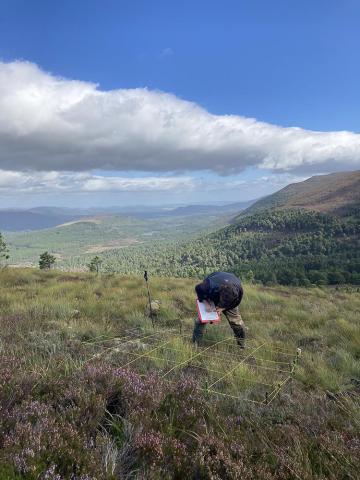Many of us will be enjoying a spell of warm, sunny weather this week, but for a few days in late August the weather was very different. Storm Ellen battered the country, but didn't stop us recording, as Chris Andrews of our ECN Cairngorms site explains.
Following the easing of lockdown restrictions earlier in the summer, much ECN fieldwork was able to resume, and in the latter half of August, staff from UKCEH Edinburgh braved the winds of Storm Ellen to collect long-term vegetation data at the ECN Cairngorm site.
Vegetation can be very sensitive to the main drivers of environmental change, i.e. climate, pollutants and land use practices, and ECN monitors vegetation for change detection using several core protocols.
2020 sees the repeat of two of these protocols across the network. The coarse grain protocol (VC) is designed to provide a record of broad changes in vegetation at a site and is based on plots selected at random from a series of systematically located grid points and with recording repeated every nine years. The fine grain survey (VF) is based on key vegetation types identified when sites were set-up over 20 years ago. Fine grain recording is repeated at three-year intervals and aims to yield more detail, allowing changes to be related to the UK's National Vegetation Classification (Rodwell 1991 et seq.). Additional protocols cover recording of linear features (VH), permanent grass (VP) and cereals (VA).
ECN monitoring at the Cairngorms site in Scotland is conducted by UKCEH. The site, which was added to the network in 1999, is one of 11 terrestrial ECN sites. There is a co-located stream site, the Allt a'Mharcaidh, which is part of the Upland Waters Monitoring Network.
Further information
- Cairngorms ECN site
- Information and data from previous surveys available from: Rennie, S., et al. (2020). The UK Environmental Change Network datasets – integrated and co-located data for long-term environmental research (1993–2015). Earth System Science Data, 12, 87-107. DOI: 10.5194/essd-12-87-2020
- Rose, R., et al. (2016). Evidence for increases in vegetation species richness across the UK Environmental Change Network sites linked to changes in air pollution and weather patterns. Ecological Indicators, 68, 52-62. DOI: 10.1016/j.ecolind.2016.01.005.
- ECN vegetation recording protocols
